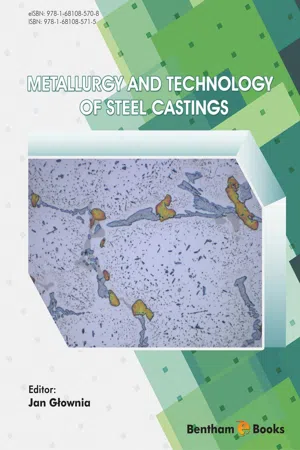
- English
- ePUB (mobile friendly)
- Available on iOS & Android
Metallurgy and Technology of Steel Castings
About this book
Metallurgy and Technology of Steel Castings is a comprehensive textbook for students and professional engineers in the field of foundry engineering and materials science. The topics covered in this book explain the association between the quality of liquid metal and the properties of the finished cast. Readers will learn about the thermodynamic conditions for addition and recovery of chemical elements (such as Cr, Ni and Mo) in steel, degasifying processes, the influence of alloying additives for manufacturing steel castings that operate in extreme temperatures, anti-corrosive steels and basic cast conditions for making the castings (pouring and heat treatment systems).
Metallurgy and Technology of Steel Castings gives readers essential information about steel and steel cast manufacturing processes and equips them with the knowledge to overcome the challenges faced in the foundry environment.
Frequently asked questions
- Essential is ideal for learners and professionals who enjoy exploring a wide range of subjects. Access the Essential Library with 800,000+ trusted titles and best-sellers across business, personal growth, and the humanities. Includes unlimited reading time and Standard Read Aloud voice.
- Complete: Perfect for advanced learners and researchers needing full, unrestricted access. Unlock 1.4M+ books across hundreds of subjects, including academic and specialized titles. The Complete Plan also includes advanced features like Premium Read Aloud and Research Assistant.
Please note we cannot support devices running on iOS 13 and Android 7 or earlier. Learn more about using the app.
Information
Cast Steels for Service Conditions
Jan Głownia
Abstract
1. Introduction

Mechanical properties of carbon cast steel [1].
| ASTM | DIN | A27 60-30 62 --35 GS-Ck25 | GS-30 Mn 5 | GS-25 Cr Mo 4 | GS–34 Cr Mo 4 | GS–42Cr Mo 4 | GS–34 Cr Mo 44 | GS–30Cr Mo V 64 | G–35 Cr Mo V 104 | GS–40 Ni Cr Mo 656 | ||||||||||||||||||||||||||||||||||||||||||||||||||||||||||||||||||||||||||||||||||||||
|---|---|---|---|---|---|---|---|---|---|---|---|---|---|---|---|---|---|---|---|---|---|---|---|---|---|---|---|---|---|---|---|---|---|---|---|---|---|---|---|---|---|---|---|---|---|---|---|---|---|---|---|---|---|---|---|---|---|---|---|---|---|---|---|---|---|---|---|---|---|---|---|---|---|---|---|---|---|---|---|---|---|---|---|---|---|---|---|---|---|---|---|---|---|---|---|---|
| Quality class | I | II | I | II | I | II | III | I | II | III | I | II | III | I | II | III | I | II | III | I | II | III | I | II | III | |||||||||||||||||||||||||||||||||||||||||||||||||||||||||||||||||||||||
| Wall thickness, mm | Mechanical properties | |||||||||||||||||||||||||||||||||||||||||||||||||||||||||||||||||||||||||||||||||||||||||||||||
| up to 30 | Re, MPa | 245 | 275 | 345 | 440 | 390 | 510 | 635 | 510 | 635 | 765 | 540 | 655 | 835 | 510 | 635 | 765 | 540 | 685 | 835 | 540 | 685 | 835 | 540 | 685 | 885 | ||||||||||||||||||||||||||||||||||||||||||||||||||||||||||||||||||||||
| Rm, MPa | 440- 590 | 490- 640 | 590- 740 | 740- 880 | 590-- 740 | 740-880 | 880-1030 | 740-880 | 880-1030 | 1030- 1180 | 740-880 | 880-1030 | 1030- 1180 | 740-880 | 880-1030 | 1030- 1180 | 740-880 | 880-1030 | 1030 1180 | 740-880... | ||||||||||||||||||||||||||||||||||||||||||||||||||||||||||||||||||||||||||||
Table of contents
- Welcome
- Table of Contents
- Title
- BENTHAM SCIENCE PUBLISHERS LTD.
- FOREWORD
- PREFACE
- ACKNOWLEDGEMENTS
- Introduction
- Fundamentals of Melting Processes
- Slags
- Gases and Non-Metallic Inclusions in Steel Castings
- Deoxidation
- Secondary Metallurgy for Small Ladles
- Cast Steels for Service Conditions
- Steel Castings for Low Temperature Application
- Corrosion – Resistant Cast Steels
- Heat – Resistant Cast Steels
- Wear – Resistant Cast Steels
- Pouring Systems and Rising
- Heat Treatment of Steel Castings